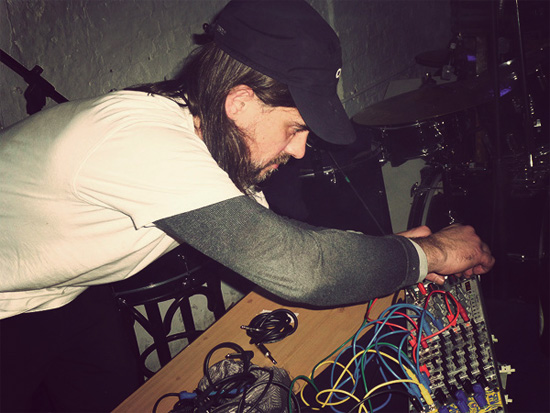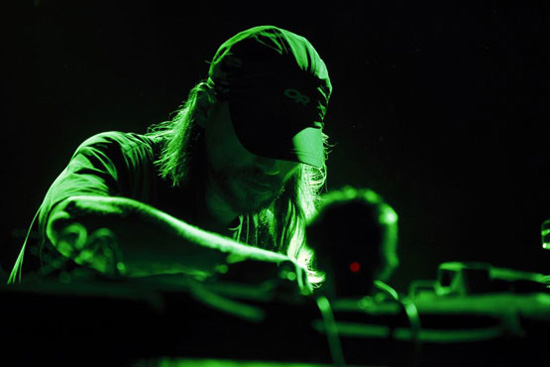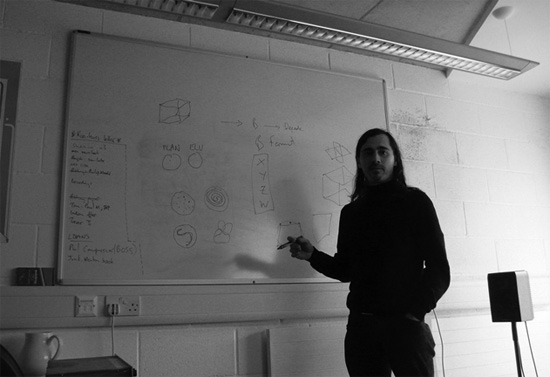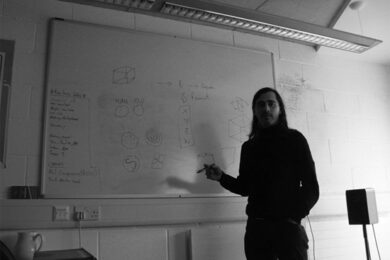"The art of our century has continually confronted its audience with a series of dislocations that are meant to be enjoyable and, in equal measure, to jolt us out of our complacency. In our times all ways of making art … are legitimate. Painting and sculpture … are as valid as installation, performance and high-tech methods of producing images to lodge in our minds." So said art historian Norman Rosenthal, in the catalogue for the controversial Sensation exhibition he co-curated with Charles Saatchi at the Royal Academy, London in 1997.
At around the same time, multi-disciplinary artist Russell Haswell was featuring in similar exhibitions of ‘Young British Art’, alongside the YBAs and other international artists. His increasing investigations into sound drew upon his fascination with new technological methodologies and the more ‘challenging’ new music genres of the time: grindcore, hard techno and Japanese noise. But despite this focus on audio and its traditional mediums of vinyl, CD and gigs, Haswell’s output bears all the qualities of Rosenthal’s end-of-century definition of art: it is confrontational, it is dislocating, it jolts us out of our complacency, and, consequently, it is highly enjoyable. Indeed, it also promotes the concerns of a visual artist over that of a musician. From his electro-acoustic explorations using systems designed by Greek composer Iannis Xenakis, through his improvised laptop noise sessions (that he describes as "temporary public sculptures"), to his more recent modular synth ‘workouts’, Haswell’s productions, like a painter or sculptor, play primarily with the power of contrast and sensation, eschewing common concerns (such as rhythm and melody) of most other musical matter.
Perhaps due both to the art world’s continued visual-centric nature and Haswell’s own deep passion for a highly specific array of audio forms, functions and formats, you’re as likely to find him in a "scratchy" venue or record shop as you are in galleries or in residency at some academic institution. The first time I saw him perform was as part of Warp Records’ tenth birthday celebrations in 2000, where he DJ’d alongside long-term friend Aphex Twin. At the end of a long night the hedonistic crowd were anticipating more beats to bob to, but Haswell and James fired up an aural assault that killed most of the movement in the room, although some gurners still tried to dance as a growing war zone of shredded, explosive samples cast confused and concerned expressions all around.
Haswell’s associations with techno’s more wayward artists extend back to the late 80s, when he first met people who would go on to be associated with the likes of Mego and Warp, such as Peter Rehberg and LFO. Rehberg’s Mego label (where the majority of Haswell’s work continues to be published), was the first to release the artist’s fiercely stunning debut LP Live Salvage 1997-2000 in 2001, positioning him in the first ‘wave’ of laptop musicians. Given such associations – including extensive touring with Autechre – over the years he has been regularly encouraged to produce a record ‘with beats’, something he largely avoided until approached by Diagonal Records’ Oscar Powell last year. The resultant record 37 Minute Workout was released last month, and is still far from a series of dancefloor anthems, possessing all the queasy qualities of his previous, perplexing productions. During the week following its release, the Quietus sat down with Russell Haswell to unravel parts of his strange world that deftly confuses art and music.
I no longer really use the computer
[Asked whether he finally became fed up with people focusing on whether his output had beats or not] I guess that’s become a topic of conversation with [37 Minute Workout] because anyone familiar with my previous records will be aware that there weren’t any beats on them. But the fact that it’s got beats now, it’s nothing. In a way, I haven’t really done anything different – it’s the same as it was before. The big difference for me, in terms of my recent output, is simply down to the fact that I no longer really use the computer as my performance tool or compositional tool, now I use a synthesiser. I’ve always, always, always been interested in synthesisers that didn’t have keyboards, because I didn’t want to do this musical thing and, a few years ago, I started to put together a modular synthesiser.
When Oscar Powell from Diagonal asked me to make this new record I’d just bought a bass drum, a snare drum, a hi-hat and a clap module. I made [the album] very quickly, within two days, apart from one track [‘Blast Beats (Edit)’] made the year before, when I was generating material for a [forthcoming] collaboration record with Pain Jerk [Japanese noise artist Kohei Gomi]. Anyway, one of the tracks that I’d recorded in my sessions for our collaboration I ended up using for the [Workout] album because it was generated in quite a different way to the rest of the tracks, and I felt that it was contrasting to the other material. In my mind it fitted into the larger picture, as I saw the shape that I wanted the album to be, because when I make a record I usually try to imagine it all… I go with a plan, I have an idea in mind, even though I’m improvising in terms of the recording, I still have an idea of what generally I want this track to be like.
It’s very similar to Stock Aitken & Waterman
[Asked if he captures his ideas for tracks, for example in storyboard form] I have notes, I have scraps of paper, you know. Once I’ve recorded one track then I’ll think, well, the other one ought to be slightly different [laughs], it ought to have a slightly different sound, maybe it wants to be more aggressive, or maybe I want it to be ambient, or I want it to be whatever. So it’s very similar to, in a way, Stock Aitken & Waterman. I’m heavily influenced by things from my past, even producers or artists who have made records I actually don’t necessarily like, I could still be influenced by in some way. Maybe I’d be interested in how it was edited, or the equipment that was used, or the style of the music, [or] in some way I might be parodying something.

Live Salvage 1997-2000
The first album I ever made, the first Live Salvage album – it took that shape because Peter Rehberg from Mego asked me to make a record, and I didn’t have any equipment beyond the laptop and I wasn’t interested in making some kind of electroacoustic, composed thing. I’m really interested in improvisation and the here and now, that’s why I did gigs and performances in that way with the laptop. As a result of either me recording it, or other people recording the gigs, I see all the Live Salvage albums as like a catalogue or an archive, in a way. If I was a painter and I’d done an exhibition, then I would hope there’d be a catalogue to document those paintings and, in a way, it’s exactly the same with those Live Salvage records.
On a love of Japanese noise
The very last Live Salvage album, the one that ‘s called In It – every recording on that record was recorded while I was on tour with Autechre. That tour was the first time I did any gigs without using a laptop, but it was before I got a modular synthesiser. It was like a transitional period, and so it was all little noise boxes and distortion pedals, and it was really new to me. In a way it was more traditionally like Japanese noise and, to be shamefully honest, it was totally inspired by all the Japanese noise artists I’ve seen in Japan, or ones that I was involved in bringing to the UK like Merzbow and Masonna. I’d spent years trying to bring The Incapacitants to the UK. I was beaten in that quest – somebody else brought them to the UK before me – but that was something that preoccupied me for about ten years.
I’ve always been interested in contrast
[On being into both grindcore and techno at the same time] Everyone else that I knew that was into one or the other was quite strict, even fascistic, they were only interested in one part of one scene, and I was always interested in the contrast. So I loved going to see Napalm Death and then the next day going to see Jeff Mills, it makes total sense to me – I like both types of music. The energy you see at a Jeff Mills show, certainly in the early 90s, I thought was as ferocious as it was seeing a grindcore band.
I like the collision of the music and that’s why, as a curator of musical events, my modus operandi is that I want to have contrast on the same night, the same day, I want to have a techno DJ and then I want to have a noise band or a grindcore band or a free improviser. If Derek Bailey was still alive, I’d want to have Derek Bailey and then Carcass and then Jeff Mills, y’know – what a line up, perfect. That’s a good night out as far as I’m concerned – variety is the spice of life. And then I feel like a matchmaker, and I’m putting these people together and seeing whether they collide or whether they blossom, maybe even things come out of it. Hopefully some of the curating I’ve done, it’s influenced some of the changes that have happened afterward in that person’s music or style of music.
When I was in New York I curated at the PS1 Museum these things called ‘Warm-Up’. They were on Saturday afternoons and, for example, I got Yasunao Tone to play. I’m interested in Yasunao Tone because of his manipulations of CDs, trying to add errors into something that’s so clinically straightforward and, in a way, so predictable – he’s trying to fuck that up and that’s interesting to me. Just like you could say Napalm Death are trying to fuck things up, because they’re doing music that’s was so fast or so short.
And then when Barry Hogan from ATP said he wanted me to do an All Tomorrow’s Parties [the Easy to Swallow events, London 2005 and 2006], the first one – [I got] Whitehouse and Aphex Twin, Yasunao Tone and Florian Hecker, Regis and Surgeon and Carl Michael von Hausswolff all on the same bill, in one night, in a nightclub! This was key, this is really important to me. I was a happy boy those nights, and both of them sold out. Totally.
I want it to be quite challenging and disparate and contrasting. You know, it’s like when you see the sushi menu, and it says "challenging", the sea urchin or the eel or whatever, that’s where I think what I do fits. Whether it’s what I release as records or whether it’s what I do as a curator, I want my stuff to fit into the challenging area or category.
But [also] I don’t want it to fit, y’know, just ’cause I’ve made a record with beats and people seem to like it more than the free noise that I’ve been doing with computers… My beat record is intentionally not one genre of music. In terms of its references, it’s equally as influenced by seeing Whitney Houston in 1988 at the Birmingham National Exhibition Centre as it is as going to see Napalm Death, Carcass, Entombed or Immortal.
On seeing Whitney Houston live
My friend who’s a sound engineer for most of the Earache bands, one of his friends was the runner for Whitney Houston, and that’s why we got front row seats. I think we were the only white people in the first few blocks, and I was for sure the only person in the audience that had a Carcass t-shirt on, and people were looking at us like ‘what the fuck are you doing here?’ We got some evil stares and we didn’t stay for the entire gig because, I don’t know, forty minutes into the gig it turned into a gospel thing and we just left then. But we went backstage, we hooked up with his friend who’s the runner, we wandered around, we nicked a beer and then, if my memory serves me correct, we got in the car and drove to Birmingham and saw some metal band. So the same night we went to a scratchy, brutal metal thing after being in the NEC with 10,000 people seeing Whitney Houston. I distinctly remember the first track of the gig was ‘I Want To Dance With Somebody’, and the band’s there and the audience are all excited, but Whitney didn’t come on to the stage for something like fifteen minutes and it was like this epic, extended version of ‘I Want To Dance With Somebody’. The tension was just building and building and building and building. When she finally came out and appeared at the top of some staircase thing on the stage, the crowd went mental – it was rocking, it was absolutely incredible.
I’d love to do gigs at schools
[Asked about his performances where visuals are directly correspondent to how the sound is being shaped] There’s a synaesthesia going on and what you hear is actually what you see. I’m steering the shapes, I’m steering the sound. It’s not like a screen saver on iTunes, it’s an analysis meter that’s used in professional studios. If you go to a vinyl cutting studio you’ll see these meters called a phase scope, and it’s showing the phase and the stereo width of the sound, so I’m playing with that. I can make shapes and I can fold sounds to make shapes. So can anyone else if they get to it, but it’s just something I get a kick out of.
When I’ve done this in front of some children at some points, it melts their brain that they see and hear the thing at the same time. I mean it’s a bit like an Oscar Fischinger animation with sound edited, so you hear a sonic event and you see a visual event at exactly the same time – this concurrence occurs. I’m not the only person to do these things – historically there was Ron Pellegrino [a pioneer in the electronic arts of sound and light], and more recently Ryoji Ikeda and Carsten Nicolai worked with this but did it in more, let’s say, sample playback fashion, in the sense that they knew what shape is going to result and it’s about repeating these things. Whereas I’m trying to do it real time, as it is, where it is right now, and I want error to be added, and I want to be able to mutate it and for people to see that that process is happening in real time and has that concurrence.
It’s immediate and, like I just mentioned, children are really like ‘wow’ [gasps] – they love it! I mean I’d love to do gigs at schools or something like that. It just seems logical to me. Recently I had a couple tell me that their six year old kid had ADHD, and that his attention span was five minutes with anything and he’s quite aggressive and disruptive – whether they give him the iPad or a new toy or whatever, he might be interested in it for a couple of minutes and then he’d just throw it at the wall, that’s it, it’s smashed. They said ‘We want you to come round to the house to meet our kid’, and I said ‘You’ve got to get him a synthesiser, it’s gonna melt his head’. I ended up going round to these people’s house and I gave him my phone which has a Xenakis-type software, based on his computer program called Gendyn, that also became one of my favourite Xenakis pieces. This kid totally got into it; he played it for about 40 minutes until the battery ran out. And the mother cried, because she’d never seen her difficult child spend more than five minutes with anything. Anyway, I liked that those things happened – I’m happy to help!
Haswell performing with oscilloscope
Acoustic ecology
[On Wild Tracks, Haswell’s 2009 album of field recordings which somehow still manages to sound a lot like one of his noise albums] The thing about Wild Tracks is that it’s totally honest. Those things are what they say they are, that is a waterfall, it’s not some white noise that has been filtered a bit, it’s genuinely that waterfall. The helicopter ride is really a helicopter, and I really recorded it binaurally and I was really in a helicopter and that’s it, that’s what it is – totally black and white honesty. I like this kind of honesty, I hate where people have to make things up – you see, I still want to have some mystique in my records, or my oeuvre, but I don’t want it to be bullshit, and I don’t want it to just be flamboyance. I want it to be real and reference-able and have a kind of linearity to its origin, not necessarily what it is in the end as an artwork, but you should be able to trace where it is or what it was or how it happened, where and why and when and so on.
The Wild Tracks thing came around in a way because I’d spent so much time with Chris Watson. [He’s] just someone I love working with and I love his past and his history, and there’s nothing I like more in the world – other than a few things we don’t need to mention in this interview – than finishing a day’s work with Chris Watson and then having a pint and a chat. I respect his work so much, and I know he’s the best in the field, and he introduced and taught me so many techniques and things about sound recording that are different or separate to sound recording in terms of making music with a band or a DJ or whatever – it’s a different art, it’s a different field.
[Asked about one of the quotes on Wild Tracks that relates to aircraft noise] You’re used to it [so your mind tunes it out normally], but the moment you’re recording it you bloody notice it ’cause it fucks up all your recordings. Yeah, well imagine being an actor and working in a TV series, it’s filmed on location, people who are location managers – they’re thinking about this, and they’re thinking ‘this place ain’t on a flight path’.
[The shrinking of places like that] will lead to acoustic ecology. I worked with Bernie Krause, who was the guy who demonstrated the Moog to the Beatles and the Stones and to Hendrix and he also played one of the synthesisers on Apocalypse Now. But he left electronic music behind at some point in the 70s and he started to record environments that are going – so rainforests that are being cut down, he’s got days, months of recordings of places that no longer exist, ’cause they’ve been hacked down or disappeared. And he’s killer. [He was in a band, too.] Beaver & Krause they were called, they did these, not ‘teach yourself electronic music’ but a kind of a description of electronic music, so how you would go and use a synthesiser. You’d listen to this record, and that’d teach you what VCO is, what you can do with it and how you do it, and so on. These are killer records.

Antoine Brumel’s Missa Et ecce terræ motus
[On working with a vocal ensemble for an upcoming commission at Aldeburgh] Yeah, Exaudi, they’re the choir that you get to do serious shit. It’s a 15th century vocal mass for twelve singers, and the original scores were eroded and the final part is incomplete. Over the years different groups, performers, conductors have tried to interpret how it finished, because they’ve got these little bits of it that are left – the only bit of page three is one square, and the only bit of page five is this other bit of a corner – so they’ve tried to interpret what it would have been in between. Because I’m not a musician and don’t read music, I’m treating it quite literally – there’s some incredibly beautiful vocal music, and my reference is Earthquake the movie from 1974, which is all about surround sound and props – the seats shook and there was polystyrene thrown at the audience and shit came down ’cause it was so loud, like plaster breaking up and falling on the people, and it was quadraphonic. So I’m going to have a 4.1 sound system with a particularly loud subwoofer, so the bass is going to vibrate. I’m basically going to make some tremors between the pieces and then in the finale, the final piece of Brunel’s mass, me and Exaudi are going to converge, as opposed to doing things one after another, but I still intend it to be quite noisy and provocative. I’m looking forward to doing it, but it’s a way away yet.
Producing Consumer Electronics
I just produced Consumer Electronics, their new album, and it’s my first production job. I thought, it didn’t do any harm when Steve Albini produced Whitehouse, so why would it do me any harm? It’s coming out on Dirter, so that’s in essence my next associated release.
The process [of producing an album, rather than working in engineering or mastering] is different, because you’re producing something rather than working with something that’s potentially finished and slightly changing it for whatever reason. But it was great to work with what is allegedly a band, like two people, and somebody who’s turning up with reams and reams and reams of lyrics. And then having to make some kind of audio contribution to sit alongside these reams and reams and reams of lyrics. It was kind of a fast process, we did it quite quickly, we made it in two days. I like working fast, and I like being instantaneous, this sort of immediacy. It was done in a professional studio. Something more professional than Consumer Electronics have ever encountered. [The album is] called Estuary English and it’s ripping, absolutely ripping, and it’s got beats, it’s different and I’m very happy with it.
Russell Haswell’s 37 Minute Workout is out now via Diagonal



